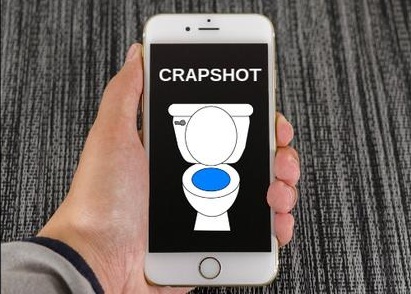WASHINGTON – Buried deep in the thousands of classified documents leaked by Edward Snowden, journalists have uncovered evidence of a little known non-kinetic warfare device currently being tested by the Pentagon. News of the technology has been kept secret for the last nine years as the Defense Advanced Research Projects Agency, also known as DARPA, continues to modify and enhance a technology developed by a scientist who was the victim of road rage. The scientist wondered if there was a way to stop aggressors in their tracks. What she developed may change warfare forever and give law enforcement a tool more powerful and effective than any weapon dreamed of in modern times.
While the documents leaked by Snowden are fragmentary, it appears that Dr. Lana Amene approached the Department of Defense in 2007 with an interesting proposal. She had developed a device about the size of a Smartphone that could be directed at a person, or persons, and when activated cause them to spontaneously evacuate their bowels. The technology delivers a potent, but harmless, laser that causes the target to suffer a fast drop in blood pressure commensurate with fluid loss, much like that of several enemas or a bad case of stomach flu. The result is a subject who is rendered temporarily weak, helpless and soiled. It did not take long for the Pentagon to realize that this device could immobilize opposition forces long enough to gain an upper hand without casualties or unnecessarily exposing friendly forces. It took even less time for the Pentagon to saddle the device with one of the acronyms for which it is justifiably infamous – CRAPSHOT – or Coercive Restraint And Punition Stand-off Harmless Obedience Technology.
When contacted, Dr. Amene would not elaborate on the details of CRAPSHOT, as the device is still classified in spite of the Snowden leaks, however, we were able to gather information from various military sources who spoke under the condition of anonymity. According to these sources, in 2003, Dr. Amene was on her way to work along Interstate I-9 in Parc, California, when she inadvertently cut off a motorist riding in her blind spot. Despite several attempts at a courtesy wave to the irate motorist, he continued blaring his horn and driving dangerously close. He followed her off the Interstate and tried to run her off the road several times. His rage continued to escalate; at a stoplight he got out of his car and began pounding on the hood of her car, screaming obscenities at her. She sped off, later calling the police, but had been so frightened she never looked at his license plate. The incident left her unnerved for several days.
According to psychologists, in order to minimize the stress and trauma of an incident in which we have experienced extreme helplessness and/or injustice, we often have what are known as revenge fantasies. These fantasies allow us to regain control of the situation in our minds and rectify a wrong. And that is exactly what Dr. Amene did. She began to fantasize of ways to stop the motorist’s behavior and humiliate him for his unwarranted overreaction to an innocent mistake. She thought ‘wouldn’t it be great if I could get him to soil himself in the midst of his rage. Stun him into place; embarrass the hell out of him.’
She continued to think along these lines as she observed other situations. In a restaurant a few days later she witnessed a man cruelly belittle a waiter in a pathetic attempt to impress his date. What if she could turn the tables and mortify the man instead? And later that week she saw three young men begin a fistfight in a shopping mall. What if she could stop them all in their tracks, turning those low hanging pants into pendulums of poop? No one would be permanently harmed, but what a message she could send. What manners she could impart. She believed the world would be a kinder place if lapses in civility had consequences.
The diminutive Dr. Amene is a popular research scientist at Arsch-Backen, a global biotech laser manufacturer. She is best known for her groundbreaking studies in furthering the application of Ureteroscopic Laser Lithotripsy for Urinary Kidney Stone Disease, to other diseases, notably difficult to treat cancers. Her colleagues were stunned at the news that she had developed the CRAPSHOT. One in particular wondered if he really had had the flu or whether he was an early and unwilling test subject.
Dr. Amene began developing CRAPSHOT, using her intimate knowledge of the now common laser treatment for kidney stones, in a device that would not only cause momentary loss of sphincter control but also rapid movement of the bowels causing intense bursts of evacuation. She was confident that her first tests of the device would not cause permanent harm but she needed test subjects. Her scientific ethics prevented her from testing subjects without their knowledge and anonymous sources say she became increasingly concerned as the temptation to use the device in near daily situations was becoming difficult to resist. She noted, in particular, a very contentious condo board meeting during which she repeatedly fingered the device in her purse, aiming, but not firing, at one of her neighbors who would not stop complaining.
Dr. Amene realized that civilian applications for this new technology would be extremely welcome and cost effective for medical procedures, like colonoscopies, which require bowel cleansers such as enemas, laxatives or the need to drink large amounts of vile tasting liquids and then spending the better part of a day or night dealing with intestinal purging. But she worried that medical professionals would be tempted, much like she was on a near daily basis, to use CRAPSHOT for non-medical procedures.
This was when she approached the Pentagon.
A popular misconception is that new military weapons or weapon systems testing is done on Marines. Their ability to tolerate pain and discomfort is legendary, but there are simply not enough of them to expend on the many weapons being tested by DARPA at any one time. Instead, the Department of Defense issues a Call Out for Testing Subjects (COTS) asking for volunteers across all military service branches. COTS are only issued after technologies are proven to be free of long term side effects. The system is not perfect, however, and in a few isolated cases COTS volunteers have suffered ill health effects years, sometimes decades, later from technologies believed to be benign. It proved extremely difficult, therefore, to recruit volunteers for CRAPSHOT. Potential volunteers not only feared the short term effects, but also feared that these effects might arise again months/years later. Defense officials called on enlisted men to do their duty, but it was not until COTS compensation for time and inconvenience was raised to record levels that enough volunteers signed up to test the efficacy of CRAPSHOT.
Even during initial testing, the Department of Defense was shocked at the effectiveness of CRAPSHOT. Test subjects noted that it was impossible to think straight for several minutes after they had been subjected to the CRAPSHOT laser. One test subject’s notes revealed that he had been injured in Iraq and was able to override the pain of his injuries, continuing to lead his men through a tough engagement. But under the influence of CRAPSHOT, he was weak and so mentally confused he could not think of anything other than his discomfort, even though he knew it would be temporary. Other test documents revealed similar reactions. These tests are revealing that the brain has a difficult time interpreting incoming signals and sending outgoing messages during periods of intense intestinal purging. “I think I’d rather take a bullet”, was one comment left by a test subject on his COTS feedback form.
Military leaders began theorizing on the different applications for CRAPSHOT and testing to determine the optimal range, the number of people CRAPSHOT could affect at any one time, the duration of the immobilizing effect and the size and battery strength of the device itself.
“It is impossible to overestimate the potential situations in which CRAPSHOT will be an asset. Not only will it be effective in close quarters combat, surges and rescue missions, but in today’s combat engagements it is often difficult to determine combatants from non-combatants. CRAPSHOT gives us the ability to immobilize those we strongly suspect of being complicit with the enemy without harming them permanently,” a former senior defense official revealed.
Law enforcement, both federal and state, are closely monitoring CRAPSHOT and have been quietly lobbying legislators to allow them to use the technology, noting that it goes beyond military applications. The use of CRAPSHOT for quickly immobilizing perpetrators, effective riot control and controlling hostage situations is of great interest to public safety agencies. “This makes the stun gun look like an iPhone 3,” one legislative aid commented.
The device itself is simple to operate and needs only general inputs for ranges both in terms of depth and width – similar to a weapon that shoots single or multiple rounds at a time. These ranges are forgiving so that quick estimates can be made under stressful situations and still allow for fairly accurate targeting. Tests are currently underway to extend the range for use in drones and manned aircraft. CRAPSHOT bombs are also being tested, although there have been difficulties with spontaneous detonation and more research is needed.
The Pentagon did not return our request for comments on CRAPSHOT but a former NSA official expressed his confidence in the effectiveness of the new weapon. “I know I wouldn’t want to be on the receiving end of that thing. I can envision large hostile groups surrendering rather than being subjected to CRAPSHOT. Right now nothing is more important than keeping CRAPSHOT technology out of the hands of our enemies.”
As for Dr. Amene, since the inadvertent release of her work she’s noticed that her colleagues and friends flinch a little when she pulls out her phone. And while she continues her groundbreaking work on laser applications for cancerous tumors, she readily admits that there are times she wishes she could dispense CRAPSHOT justice. Just this week she witnessed a teen driver texting on his cell phone while speeding down her small residential street at 50 mph. A perfect CRAPSHOT moment.






Be First to Comment